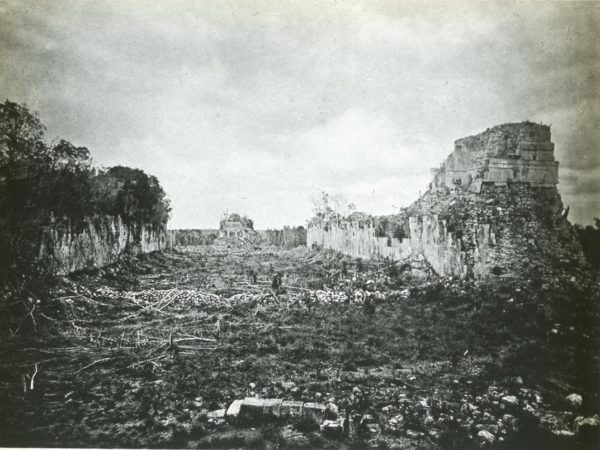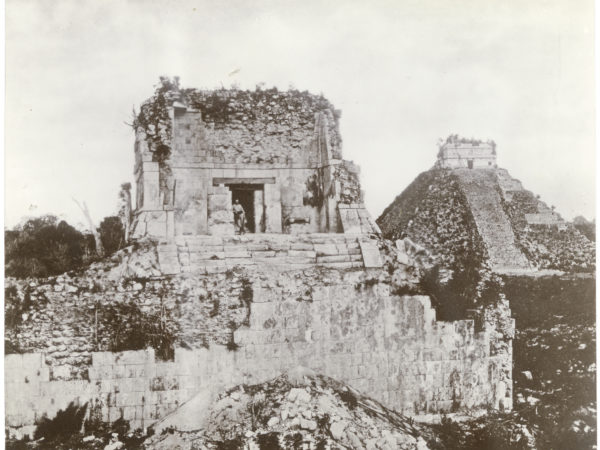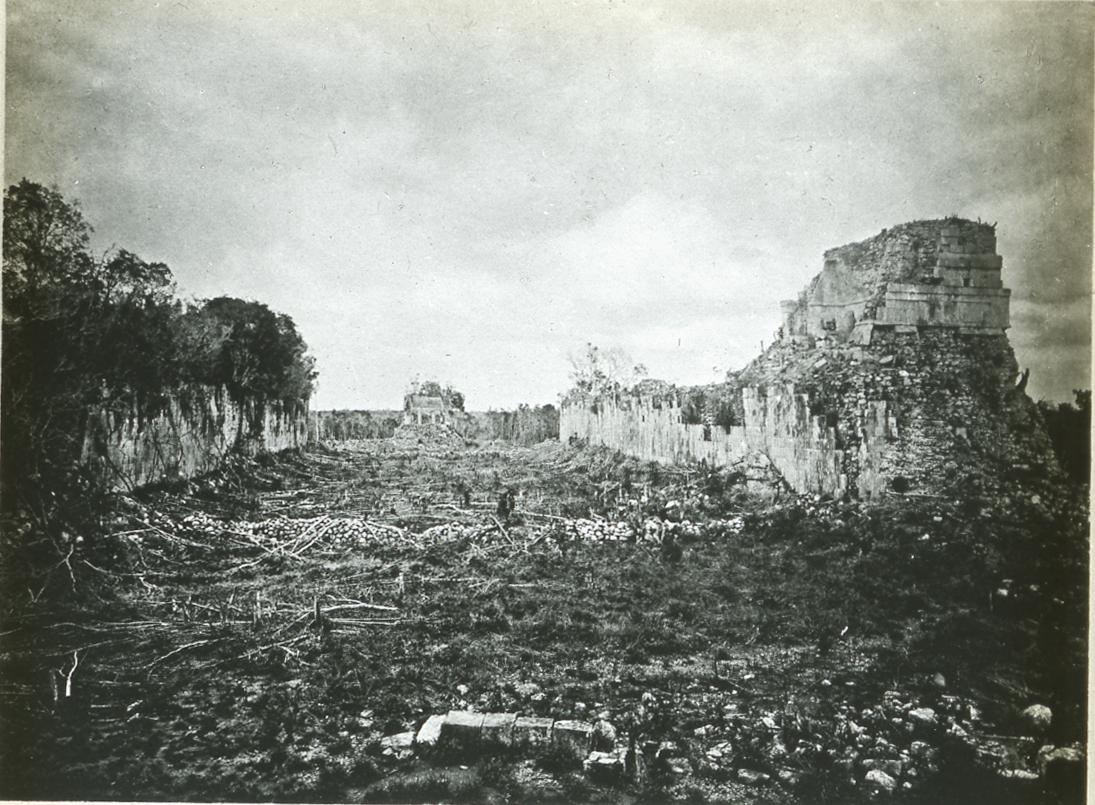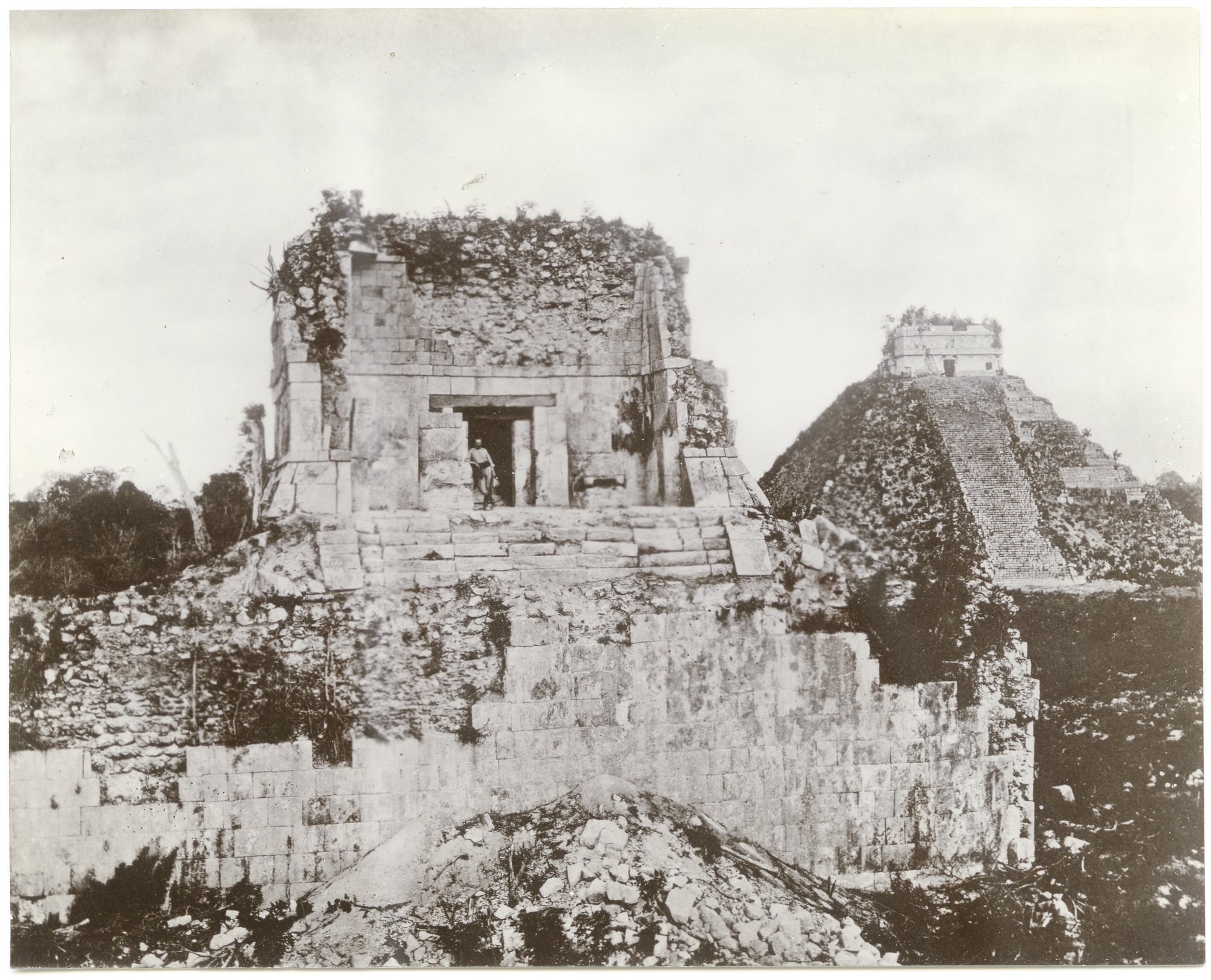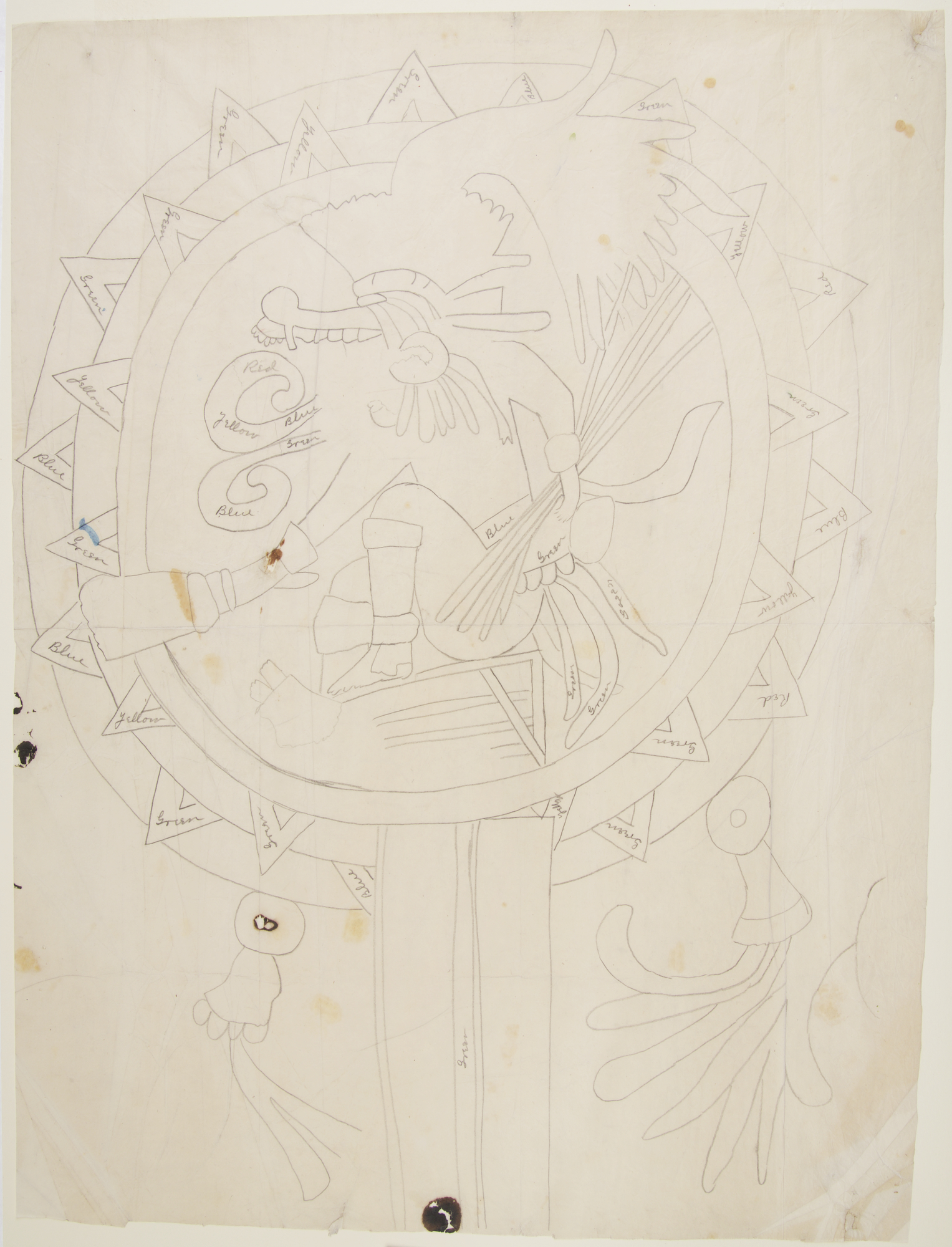Chichén Itzá
Chichén Itzá was one of the great regional centres of the Maya lowlands.
The first buildings date to about 700 CE (about 1,300 years ago), and the city grew rapidly. Then from about 870 CE, outside influences brought new ideas. Whether this was the result of invasion or migration from outside, or of local leaders adopting foreign ideas, is not clear. Archaeologists call the new culture Toltec, because of similarities with the culture in the Toltec capital of Tula, in central Mexico. But it could have been introduced by the local Maya people, the Itzá, who may have adopted militaristic Toltec ways and migrated to Chichén Itzá.
By 1100 CE, Chichén Itzá was no longer the regional centre. Elite families probably moved out and joined the new regional power based at the neighbouring city of Mayapan. Mayapan itself fell apart by 1440 CE, probably due to internal political conflict.
When the Spanish arrived in 1528, they found only a few families living among the ruins of the great cities.
Image: Plan of Chichén Itzá. Adela Breton worked at the Upper and Lower Temples of the Jaguars, the North Building, the Casa Colorada and the Monjas. From Alfred Maudslay’s Biologia Centrali-Americana, 1895 via Wikimedia Commons

1900. February 20 to April 1 … In Temple A traced and coloured the southern part of west wall fresco
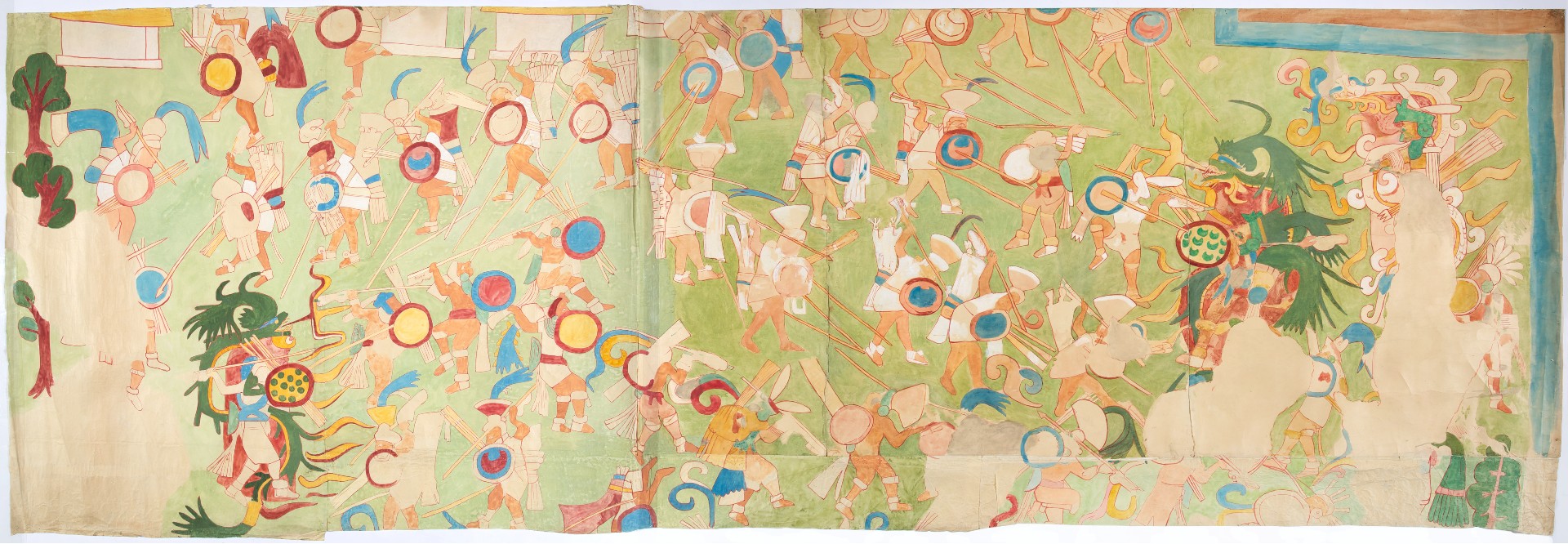
The southwest wall of the Upper Temple of the Jaguars
The inner chamber of the Upper Temple of the Jaguars (UTJ) was originally covered in scenes of warfare. The images were probably painted in about 850 CE to glorify the Toltec military elite by showing their victories. By the time Adela Breton took on the job of copying the whole chamber, about half of the wall paintings were lost. Since then, most of the rest has gone. Her watercolour tracings of the walls are the only full copy in colour that exists. These originals, and her quarter-scale copies of them, mean that academics can still study them and try to work out what is happening in the scenes, but this is interpretation and no one can be absolutely sure what is depicted.
The west wall was divided by the open doorway. The southwest panel was the most complete of the seven panels in the Upper Temple of the Jaguars. It may show a battle between two sides, or it may be a victory dance by one side.
Adela Breton used four strips of paper to copy the scene. We think she stuck the paper to the wall with some sort of gum, and lifted it up to check the painting underneath before lowering it to trace off the image. She may have measured figures to position them correctly, and she must have had steps or scaffolding to reach the top of the wall, 2.67m or almost nine feet high.
There are several interpretations of the wall paintings: here we give two versions from American academics.
Virginia Miller interprets the seven panels as reflecting the daily cycles of the Sun and the planet Venus, and the victory of the Toltec Venus-warriors over the Maya Sun-warriors.
William Ringle sees the seven panels as representing a series of historical conquests, in a building used for the investiture of military officers, and specifically the Cloud Serpent military leader.
The first strip shows 21 houses in the village, with women and old men packing up and leaving as soldiers move in.
The second strip, shown above, shows soldiers celebrating with a victory dance. Most wear a white tunic and feather headdress, and carry a shield and spears. All use an atlatl, a spear thrower designed to increase the power and length of their throw.
On the right, the legendary conquerors of Chichen Itza, Captain Serpent or Quetzalcoatl, and Mixcoatl, arrive in a blaze of glory. Both have a protective feathered snake wrapped around them, and flames radiate from their bodies showing they are powerful men.
Extract from The Wall Paintings at Chichen Itza by Adela Breton, a paper read at the Congress of Americanists, Quebec, 1901
‘Students of Central American archaeology have scarcely as yet appreciated the important part that painting formerly played in the decorative art of that region. The first explorers were overwhelmed by the grandeur and strangeness of the ruins, and were too fully occupied in making plans of the structures, and moulds of the reliefs and monoliths, to have time for more than hasty notes of colour on them. This was unfortunate, for when the buildings were covered with debris, when first excavated, the colours were often fresh, and exposure to the weather has since destroyed them.
From the remains still visible, it is evident that all the sculptured parts were coloured and that the colours were more or less symbolic. Those people saw in colour and light and shade. That is why mere outlines copies of the sculptures and casts, set up in a light for which they were not intended, give a very inadequate idea of the actual effect. The colour is also a great help towards understanding the subjects.
At Chichen Itza there was a remarkable development of Art; not only were the columns, door posts and interior walls of some of the buildings covered with coloured reliefs representing personages and events, but many chambers were entirely painted in fresco with historical scenes.
These wall paintings are of the highest interest, not only from the point of view of archaeology but from that of Art. In colour, drawing and design they can hold their own anywhere, although to the modern eye they may appear quaint and childlike as do those of the Early Italian school. As they are, unfortunately, much destroyed, they cannot be seen fairly in a hurried visit, but after studying them day by day, and when the light is good, one comes to feel a great admiration for artists who could so skilfully transfer the bright harmonious tints of their sunset skies to an intractable material like plaster.
Mr Thompson, Dr Le Plongeon and Mr Maudslay copied some portions of these paintings, but from various reasons their copies have not become known as they deserves, and it was at Mr Maudslay’s suggestion that I attempted the great task of copying the whole series.’
It is only when copying them that one can appreciate the art with which each colour is added to enhance the brilliance and harmony of the whole …

The northwest wall of the Upper Temple of the Jaguars
The Upper Temple of the Jaguars was a ruin when Adela Breton worked there. The temple had two rooms, but the roof of the outer chamber had collapsed. The rubble was cleared in 1875 by shovelling it over the wall into the ball court. The inner chamber was described by explorer John Stephens in 1843 as ‘perhaps the greatest gem of aboriginal art which on the whole continent of America now survives.’
The walls were covered in paintings, probably done in about 850 CE. They were damaged by rain running down the walls (due to clearing the trees that had helped to protect the ruins), bats, swallows and bees nesting inside, and visitors writing their names in charcoal.
About half of the painted surface was missing of the northwest panel. It shows an attack on a fortified town by the Toltec.
Adela Breton used four strips of paper to copy the scene (above). We think she stuck the paper to the wall with some sort of gum, and lifted it up to check the painting underneath before lowering it to trace off the image: there are two repaired cuts that divided the long strip into three to make this easier.
Adela Breton spent up to four months a year at Chichén Itzá, from 1900 to 1904. She talked of life there as a ‘struggle to exist and work’, and wrote to her colleague Alfred Tozzer about being ‘dead tired after long days in that hot Painted Chamber with every nerve quivering…’. Yet she carried on until the job was finished.
There are several interpretations of the wall paintings: here we give two versions from American academics.
Virginia Miller interprets the scene as part of the sun cycle, set in the afternoon, which is linked to the defeat of the Maya in their battles with the stronger Toltec invaders. The Sun Disc represents the setting sun and defeat for the Maya forces.
William Ringle interprets the wall paintings as an historical record of real or semi-mythical battles. They were painted in a ceremonial building used for the investiture of the supreme Toltec military leader, who ruled Chichén Itzá alongside the local political and religious leaders. Their purpose was to glorify past victories.
He suggests that this battle, in a fortified village, is actually one Toltec group attacking another, rather than fighting the Maya or other groups.
Chichén days
Extract from Adela Breton’s diaries, as sent to Alfred Tozzer
February 20 to April 1.
Nearly died of fever, ticks and hunger. Took the Maudslay plates of sculptured Chamber E [the Lower Temple] and coloured them, the colour being often visible in the hollows of the reliefs, or sunk into the stone where the surface is weathered. It also varies according to the light.
In Temple A [the Upper Temple] traced and coloured the southern part of west wall frescoes and the piece over the door. Went over carefully the Maudslay plates, [for Alfred Maudslay’s great book on Mexican archaeology], for corrections and compared the inscription in Casa Colorada with the plate. Made a careful coloured drawing with full details, of the façade of the Monjas annexe. Stayed part of the time in the Akab Tzib. (Visited Uxmal)
